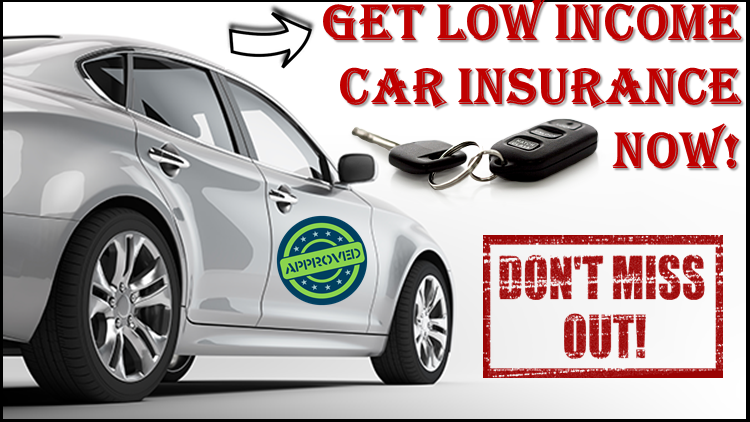Low Income Car Insurance
Company Trusted For Over 25+ Years*

Call us 1-855-620-9443
Company Trusted For Over 25+ Years*

Today there is so much political talk about income inequality and the top 1% of earners in America. It seems the rich have always gotten more affluent, but since the great recession, the gap has widened even more. Those who need essential services, like low income car insurance, struggle to get by.
Middle-class workers are often taxed at a higher rate than those wealthy taxpayers, especially with long capital gain income assets, like stocks and real estate. Even more frustrating is that those on the lower end of the earning scale pay more for life’s essential expenses like auto insurance.
Logically, low income car insurance should be cheaper, but this is rarely the case. Workers making less than $50,000 annually pay some of the highest rates for standard auto insurance coverage. This phenomenon can be attributed to many reasons. One of the main reasons low-income individuals pay more for auto insurance coverage is their riskier to insure. Stats show lower-paid workers have worse credit scores and file more claims.
Because a driver’s risk determines insurance rates, insurers charge more the riskier a person’s profile is. Statistics point out that income earners making under $4,000 a month get into more accidents, have more reckless driving tickets, and are more frequently late on paying their premiums. These factors result in higher premiums for the same group of drivers who need car insurance for low income.
Let’s explore further why insurers charge less to the top wage earners. Get your custom online quote from Good to Go Insurance company and lower your premiums immediately. Start by entering your zip code.
It sounds discouraging to all those laws-abiding, hard-working Americans that make a low wage and then get charged more for car insurance than those earning over $100,000 yearly. Even excellent drivers with a clean driving record often pay more if their annual income exceeds $50,000.
Auto insurance providers run sophisticated algorithms to determine a driver’s risk and, thus, the rates they will pay to get insured. This way, you are asked many personal questions when applying for coverage. Have you ever noticed how many questions relate to your finances? Some of the most common things asked to include:
According to the firms that set insurance prices, you might think these are all irrelevant questions that have nothing to do with your driving ability, but not so. One often overlooked yet significant factor is a socio-economic one – how much someone earns. One insurance federation study found that so-called “blue-collar” workers paid almost 60% more for the same coverage as white-collared professionals with a similar driving record.
In some parts of the U.S., the gap is even more significant, and finds low income car insurance rates more than double what higher earners pay. This discrepancy in premium charges goes back to the infamous data that backs up the insurer’s decisions on segmenting pricing for higher-income earners.
The stats point to lower-wage workers getting into more accidents, having more significant lapses in coverage, and driving recklessly more frequently. The reality is that not all people with a modest income are high-risk drivers, and this discrimination in rates is a practice that needs to be stopped.
One step anyone can take is to set a higher deductible amount. This decision may be challenging if you don’t have much savings, but it’s essential if you want to lower your premiums. It might seem unfair, but those motorists with a lower wage need to be aggressive and control the insurance buying process.
One aspect of auto insurance coverage costs you, as a driver, have total control over is the deductible. Get a policy with a $1K deductible and save about $150 or more per year. The higher you set the deductible, the lower your premiums will go. Another tip is to keep your credit score high. Even if you are on the low end of the wage scale, you can control your credit and get it higher as soon as possible. Doing so will lower your car insurance costs quite a bit. Another quick tip is to garage your vehicle. Garaging your car at night can save you 2% or even more.
The most important tip for those hard-working people with lower incomes is to shop around online. Some of the cheapest car insurance plans are often found online. This is because it’s so much more cost-efficient for insurers to sell policies direct without paying out massive commissions to brokers. Also, make sure you compare at least five rates to have a good idea of the price differences for the coverage you want.
Several insurance providers offer cheaper car insurance for low income earners. Rates can vary a lot, so compare quotes from each provider. The more quotes you get, the greater your chance of reducing your premiums.
The internet has made shopping for low-income car insurance an easy process. You can compare up to 10 auto insurance quotes with Good to Go Insurance in about 5 minutes. You can use your smartphone to get a quote in no time. Best of all, you can save time and money shopping for automobile insurance with GoodtoGoInsurance online.
You can also take advantage of numerous online discounts that save you more. Get your best rate today with good2go insurance direct. All you need to do is start by entering your zip code. Get started and lower your car insurance rates.